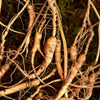All You Need To Know About Ginseng Hunting

Several people all around the world are rooting on herbs and natural products to keep them healthy. Many popular herbs are in demand for their health benefits, and one such product is Ginseng. Ginseng refers to 11 different varieties of slow-growing plants that have fleshy roots.
There are two main types of Ginseng – Asian ginseng (Panax ginseng) and American ginseng – (Panax quinquefolius) that offer vast benefits. Both types are believed to reduce stress and promote relaxation. They also lower blood sugar and cholesterol, treat diabetes, boost energy, and cure sexual dysfunction in men.
Ginseng can either be wild or cultivated. Wild Ginseng grows naturally in the mountains and is hand-picked. The gatherers who harvest Wild Ginseng are known as ‘Simmani.’ Due to the high demand and harvesting of these plants before they can reproduce, Wild Ginseng is extinct in China and is endangered globally.
Cultivated Ginseng is less expensive compared to wild ginseng. At present, wild cultivated ginseng is planted on mountains and is allowed to grow like wild ginseng.
How to hunt for Wild Ginseng?
American Wild Ginseng is listed as an endangered species, and hence its harvest is regulated. It is exported to China at a considerable price due to its increasing demand. To ensure the long-term survival of wild ginseng, sustainable harvesting practices are suggested.
Ginseng hunting or ‘ginsenging’ is a serious pastime in states where it grows. It is best harvested during the ginseng season. But as a hunter or dealer, you will require a state license or permit.
There are four easy steps to hunt wild ginseng.
1. Identify the plant
Without knowing what you are hunting for, you will never be able to find it. The first step to ginseng hunting is recognising the plant. You can look through illustrations on the internet while you understand how the plant can be distinguished from the others.

How to recognise a Ginseng plant?
Ginseng is a small, shade-loving plant with a light-colored, forked-shaped root and a relatively long stalk that features oval-shaped green leaves. A mature plant will have three to five compound leaves, and each comprises three to five leaflets. At three years of age, the plant grows a cluster of dull-yellow flowers in spring. These develop into a cluster of bright-red berries located just above the point where the compound leaves join the stem. The berries grow in early fall and contain seeds. Depending on the weather and climatic conditions, germination takes anywhere from 18 to 22 months. A fully-grown ginseng plant grows up to two feet tall.
2. Identify the habitat
If you are in pursuit of wild ginseng, you must carefully identify its habitat or a place where there's a good potential for its growth. Ginseng typically appears in deep forest areas with 70 to 90 percent shade.
It usually lies on North or East-facing slopes in hardwood forests and thrives in well-drained loam soil that gets 35 - 50 inches of rain. In the US, harvesting Wild ginseng is regulated only in 19 states. Alabama, Arkansas, Georgia, Illinois, Iowa, Indiana, Kentucky, Maryland, Minnesota, Missouri, New York, North Carolina, Ohio, Pennsylvania, Tennessee, Vermont, Virginia, West Virginia, and Wisconsin.
3. Hunt during the ginseng season
Wild ginseng cannot be harvested all year long. There's a short bracket within which you can harvest them. It is important to ensure that you hunt during the ginseng season, failing which you might further endanger this herb.
Ginseng can be legally harvested from 1st September to 31st December in the USA. You just need to make sure that you aren't in a state where ginseng harvesting is prohibited.
4. Harvest the ginseng root
Harvesting a ginseng root is not as difficult as it seems.
Dig at least 6 inches deep in the soil from the plant and carefully work your way down to the root.
Pull up the root carefully, ensuring the tiny rootlets attached.
Break off the stem while keeping the root neck intact.
Remove the seed-bearing berries and bury them where you found the plant.
The harvested root must be carefully cleaned with water, after which you must air-dry the cleaned roots for one to two weeks.
Summary
Ginseng roots have a lot of medicinal value, because of which it is in demand. Due to wrong harvesting methods, however, wild ginseng is extinct in China and globally-endangered. To ensure that we do not lose ginseng forever, there are regulations when it comes to hunting and harvesting this herbal root.
-
Posted in
How To's
 Stamina
Stamina Energy
Energy Immunity
Immunity Antioxidant
Antioxidant Beauty
Beauty Fitness
Fitness Blood Circulation
Blood Circulation Liver & Heart
Liver & Heart Bones & Joints
Bones & Joints Eye & Brain
Eye & Brain Digestion
Digestion Relax & Sleep
Relax & Sleep For All
For All Men's Health
Men's Health Woman's Health
Woman's Health Kid's Health
Kid's Health Jar
Jar Stick
Stick Pouch
Pouch Root & Slices
Root & Slices Shot
Shot Pill
Pill Tea & Powder
Tea & Powder Candy
Candy

 Our Brand
Our Brand Korean Red Ginseng
Korean Red Ginseng Premium Ingredient G1899
Premium Ingredient G1899





